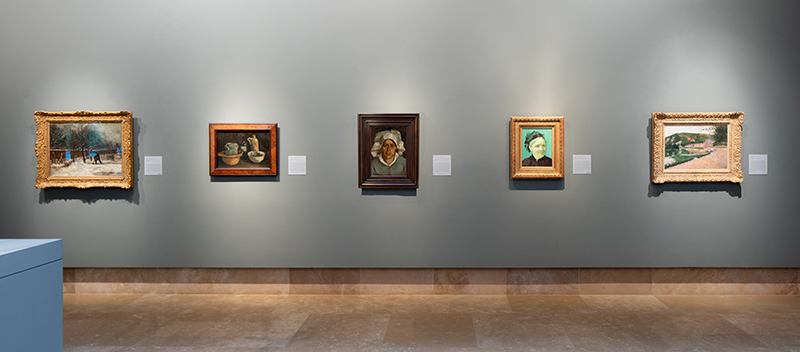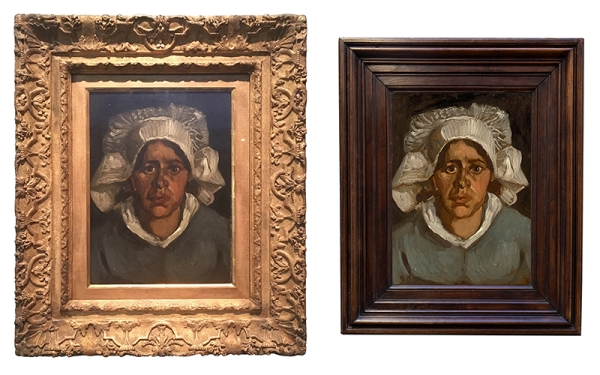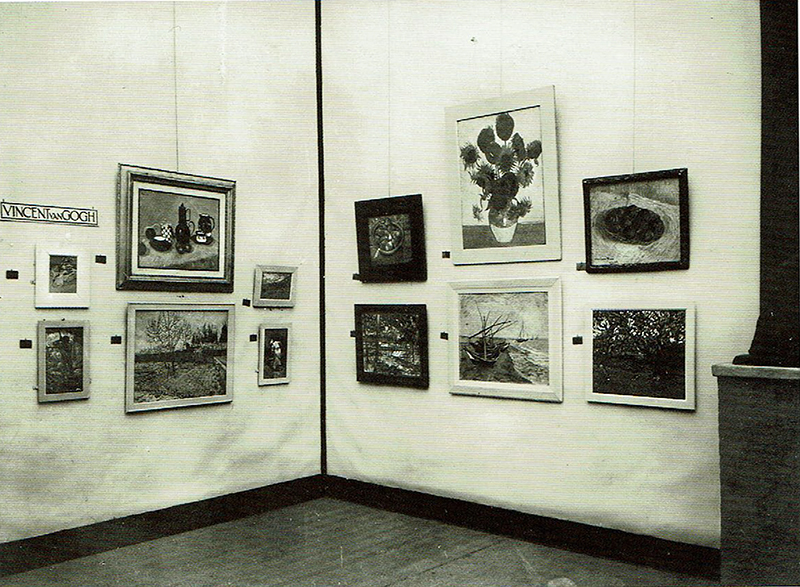Reframing Vincent van Gogh’s "Head of a Peasant Woman in a White Bonnet"

Head of a Peasant Woman in a White Bonnet installed in the Museum's 19th-century art gallery
Over the Summer, the Museum completed a special project: reframing Vincent van Gogh’s Head of a Peasant Woman in a White Bonnet, 1885. The image is a vivid depiction of Sien de Groot, a central figure in Van Gogh’s The Potato Eaters (Van Gogh Museum, Amsterdam), painted in the same year. He created both compositions during a formative period in his career, while living in the southern Dutch village of Nuenen. There, Van Gogh sketched and painted farmers and weavers—manual laborers—as he strived to create an authentic visual record of the life and character of his times. In a letter to his brother Theo, the artist noted, “He who prefers to see the peasants in their Sunday-best, may do as he likes. I, for my part, am convinced I get better results by painting them in their roughness” (April 30, 1885). Presented frontally and without pretension, Sien de Groot’s portrait manifests the artist’s stated intention to become a painter of the working people.

Vincent van Gogh (Dutch, 1853–1890), Head of a Peasant Woman in a White Bonnet, 1885, oil on canvas, The Norton Simon Foundation; Left: In its former frame; Right: In its new frame
In considering whether a frame enhances or diminishes a painting, we start with the work of art itself. Since the portrait’s acquisition in 1984, a carved, French Louis XIV–style frame has surrounded it. The frame is a beautiful, decorative object. However, in terms of detail, finish and scale—it is more than seven inches wide—it appeared to overwhelm this closely observed single figure. The frame’s ornamental, scrolling strapwork, and the floral motifs on the crosshatched background, competed with Van Gogh’s broad facture of dense brushstrokes, which so effectively simulate the form and texture of the bonnet and kerchief that frame the figure’s face and neck. The frame’s reflective, gilded surface overpowered the limited palette of earthen colors he employed to render Sien de Groot’s visage. Importantly, it conveyed an impression of luxury that contradicted the humble subject it surrounded.

Installation view, Vincent van Gogh section, Sonderbund exhibition of 1912, Cologne, Germany, credit: Rheinisches Bildarchiv Köln
With the goal of finding an antique frame of similar date, the Museum turned to Werner Murrer Rahmen. The Munich-based firm specializes in frames from the 19th and early 20th centuries, with an emphasis on Northern European and Expressionist artists. In addition to an extensive inventory of frames, they maintain a collection of archival photographs, including installation images of early 20th-century exhibitions, which record framing styles often selected by the artists themselves. After evaluating multiple candidates, we selected a vintage oak frame from the 19th century. Its 5 ¼ inch width complements the scale of the canvas. Simpler in style and color, and free of playful details, it carries a visual weight that is more appropriate to the modest theme, a portrait of a peasant, that it surrounds. The continuous bands of flat and curved molding are a welcome counterpoint to the artist’s densely painted, tactile surface, and the frame’s warm, chestnut tones bring out the nuances of the dark shades in the painting.
—Gloria Williams Sander, Curator
This article first appeared in the Museum’s Fall 2025 Newsletter.
—Gloria Williams Sander, Curator
This article first appeared in the Museum’s Fall 2025 Newsletter.
